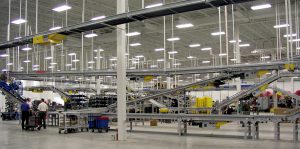Publitek interview with:
Mark Burr-Lonnon | Senior Vice President, EMEA, Asia and Global Service at Mouser Electronics
Jeff Newell | Senior Vice President, Products at Mouser Electronics
Q1. What sectors and product categories were you forecasting to see the most growth from in 2020 before COVID took hold, and how has that changed since?
Mark: As we went into 2020, we were expecting to grow by around about 8% overall, and we’re currently on a run rate of about 8.3%. Our business is looking in pretty good shape at the moment.
One of our main customer groups is the OEMs, which represent a significant proportion of the electronics industry. Small to medium electronics manufacturing service (EMS) companies are a strong group for us, and from a customer volume perspective, hobbyists and students also are a good market for us.
Despite our planning and expectations for certain customer groups and sectors, like many other companies, the year has panned out slightly differently because of COVID. The impact has so far resulted in our large-volume EMS customers being far more active than we expected and has driven that side of our business up 31% so far this year. The small to medium EMS sector are also up 10% over our forecasts, as is our hobbyist and student business which is up 15%, all very positive signs for our business as a whole. The OEM customer group, which is a significantly large group for us in terms of numbers of customers, is up 3% which is still a respectable growth considering how the industrial markets have been hit globally.
So, overall, from a sector and business standpoint, we’re pretty lucky and fortunate to be in this position.
What is interesting is the roller-coaster of demand of how things changed as COVID took hold across the world. The year started off really well for Mouser, and then around Chinese New Year (which traditionally sees a slowdown), it started to hit deeper as China went into lockdown. Europe and the Americas suddenly latched on to what was happening in China, resulting in a huge wave of business. We had one third down, two thirds up, then suddenly China bounced back while the other two-thirds hit harder times.
Jeff: From a product perspective, while we don’t necessarily forecast product growth as such, there are a number of interesting aspects worth noting.
Firstly, we fully expected the capacitor business to rebound this year. It was down significantly in 2019 because of its strength in 2018. And everybody that I was talking to, internal and external, expected that to come back. That has not happened. While the sales are down considerably, the volume sold is only down by about 3%, so we are still shipping a lot of product. A lot of growth was predicted to come from the automotive sector, but clearly that isn’t doing so well now. We’re still shipping a lot of different product lines into our automotive customers, but the quantities are relatively small, highlighting that it is more likely to be design activity rather than consumption for production.
Another category of products worth mentioning is discretes. They were up a lot in 2018, down in 2019 and have yet to recover their position. We can’t work out why, and the discrete suppliers we talk to share the same concerns. It probably requires more research and insight to make a valued judgement on this, but since discretes go into pretty much everything, it is odd for one technology to be down so much while other areas of our business are not. The only conclusion we can make is that there is either a glut of inventory, or the industries that were affected negatively; automotive, industrial, oil and gas must take a decent amount of that product, and they’re just not buying right now.
On the positive side, we expected to see growth coming from microprocessors, microcontrollers, analog, and interconnect. Those categories are up this year, and even some passive areas, such as resistors and inductors are doing very well.
Another area we wanted to focus on this year is dev tools. We’ve signed new suppliers, new lines, and many of our existing suppliers are coming out with new dev boards and evaluation tools too. The industry continues to make it easier for design engineers to design in new products, so dev boards and eval kits are all showing strong sales for us this year. Interestingly, these dev tools are easy for engineers to buy themselves, so some engineers, say a hobbyist working for an OEM, can work on a design idea from home. I’d say we’re shipping more development tools now than we ever had before.
Q2. How are your customers responding to changes COVID has forced on them, and what are you doing differently?
Mark: We’ve certainly seen a lot of design engineers set up their bench at home. California, for example, has been badly hit with virus cases, but there is a lot an engineer can do from home. I think some of those design engineers are happy because they’re sitting at home doing their work and nobody is disturbing them. Some testing might be a challenge to achieve at home, but some engineers appear to go back to the office lab just to perform specific tests before returning home.
Jeff: On that note we know that suppliers say they are having very effective calls with their customers on new design starts, using Zoom and Microsoft Teams etc. Calls appear to be very productive in that you can quickly navigate through the social introductions and get to the detail really quickly. Customers can have the right people on the call, so the decision-making process can move forward quickly. We think even suppliers have found that doing design work in a virtual setting actually works. Whether this is going to be the way it’s done moving forward remains to see, but it is very clear that the design process hasn’t stopped because they can’t physically meet in the same room.
Mark: One key decision we took was to maintain our inventory levels. It’s probably not unique, but there’s not a lot of distributors who have kept the inventory levels as high as ours. We have around $800 million in inventory at the moment, and we continue to focus on the breadth of inventory from all the suppliers, which means that it’s there for the engineer to buy.
On one of our regular supplier calls, the CEO of one of our major interconnect suppliers commented that he believed that there is a tidal wave of innovation about to happen, and that it is a once in a lifetime opportunity that is driven by electronics. We share his thoughts. His insight resonates with what we’re experiencing at Mouser, we see a lot of potential for us going forward. There is a hotbed of innovation happening in engineer’s homes at the moment, and much of that will come out into the prototype stage soon. As we entered 2020, we knew that with 5G and other major market trends the next couple years would be good, but because of COVID, there are innovations in many other areas of our industry too.
Q3. Have you noticed any specific changes in the medical electronic sector and the demand for components?
Mark: Medical has always been a good sector for us, but unsurprisingly we’ve seen a huge increase in demand, particularly across all types of sensors. Microcontrollers, analog, LCD displays, and pretty much anything that goes into a ventilator have grown significantly. Demand has been well above normal and maintaining our high inventory levels has meant we can deliver from stock – something that we are particularly pleased to be able to offer considering the intended purpose and urgency of these components.
Q4. What is the forecast looking like for the remainder of 2020 and into 2021? Are there any predictions you are confident about?
Mark: We started the year forecasting 8% growth overall, being equal across our three regions of Asia, the Americas, and Europe. As of June 2020, that growth has shaped up to become 6% in the Americas, 5% in Europe and 20% in Asia. The hardest thing to predict is how it will go from here. Already we went from a -40% run rate in China to +20%, which shows the dramatic shift over a relatively short period.
The next three months will be crucial as production is starting again in parts of Europe and the Americas. The market requires demand to work, but, for example, there are 40 million people in the US not working currently, which means they are not spending. Having said this, we firmly believe the electronics sector is not going to be hit as badly as the entertainment and hotel sectors, since innovation is still continuing.
The real unknown is the rate of staff returning to work and getting our economies back on track. The hope is that we shall see this happen during the summer. There is potential that we may see a better than average summer in Europe, as companies focus on getting back to work – it is hard to see the usual summer rush to vacation just as lockdowns are lifting.
Jeff: From the product and market trend perspective, 5G will continue to drive consumption. Government investment in 5G deployment as an economic stimulus package may happen, creating even more demand. It is no surprise that our RF product lines are experiencing significant demand across the board, including RF power transistors, RF filters and specialist RF interconnect.
Mark: All of our 27 locations around with world remain open and we’ve taken measures to protect our staff and slow the spread of the virus. We’re still hiring when we’ll need to hire people, we’ve had no furloughs, we’ve had no layoffs and we should hit $2 billion this year. Against the backdrop of COVID, we remain strong and continue to invest in our people who are working extremely hard to process orders so that design-chains and supply-chains around the world remain open.










